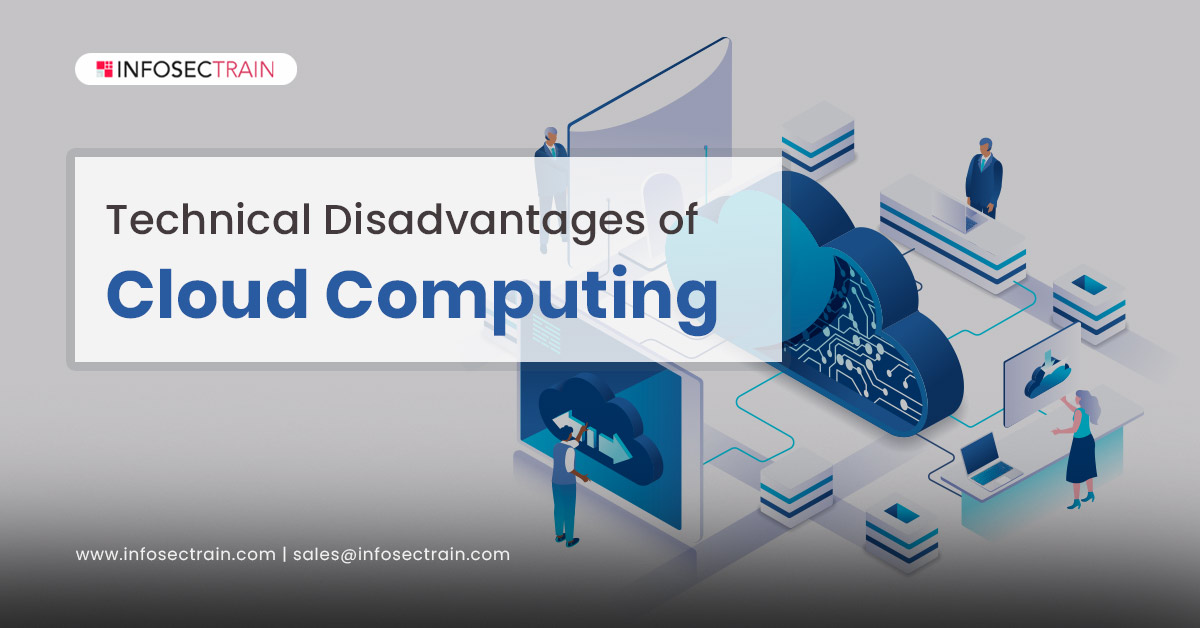Technical Disadvantages of Cloud Computing
Cloud computing is a word you have probably heard before as it is one of the hottest topics in the digital market. Professionals even use it without being aware of the concept. In today’s digital age, a growing number of tech-savvy businesses and industry leaders are realizing the many advantages cloud computing offers. It is a concept that has been increasingly popular in recent years, especially as the Covid-19 pandemic affected how businesses operate. But what the technology is. So let us first look at what cloud computing actually is.

Table of Contents
What is cloud computing?
Technical disadvantages of cloud computing
1. Risk of data confidentiality
2. Cloud downtime
3. Dependency on internet connection
4. Choosing the ideal cloud configuration
5. Issues with cloud integrity and binding
6. Lack of expertise and knowledge
7. Management of cloud
What is cloud computing?
Cloud computing is the process of storing, accessing, and managing large amounts of data and software programs through the internet. Because the program and data are stored in global data centers, you can utilize it without using your computer’s hard disc.
Though cloud computing provides enormous benefits to the globe, big benefits come with significant drawbacks, and cloud computing is no exception; thus, there are still some issues to be resolved. In this article, we will look at the technical disadvantages of cloud computing.
Technical disadvantages of cloud computing:
1. Risk of data confidentiality: Security risks in cloud computing are the most pressing concern when investing in cloud services. It is because your information is saved and processed by a third-party vendor without your knowledge. You hear about a company’s faulty authentication, compromised credentials, account hacking, data breaches, and other issues every day or so. You become a little more skeptical as a result. Users’ data is stored on remote servers that may be maintained by others and can be accessed through an Internet connection in cloud computing. There is a good likelihood that the data has been tampered with. As a result, data confidentiality becomes a critical concern.
2. Cloud downtime: Like any other IT system, the cloud is susceptible to technical issues such as reboots, network disruptions, and downtime. These occurrences might halt commercial activities and processes, which can be costly to the company. You should plan for downtime to reduce the effect and frequency of such events, as well as to provide the highest degree of service available for your customers and employees. Reviewing the SLA from the cloud service provider plays a major role in identifying the availability expectations.
3. Dependency on internet connection: A high-speed internet connection is required for cloud services. As a result, small businesses experiencing connectivity challenges should prioritize investing in a good internet connection to avoid downtime. It is because internet outages could cost any company a lot of money.
4. Choosing the ideal cloud configuration: It is critical to select the suitable cloud mechanism for your company’s demands. Public, private, and hybrid clouds are the three types of cloud configurations. The key to a successful cloud installation is selecting the appropriate cloud. If you don’t choose the appropriate cloud, you could be in for some real trouble. Because some businesses have a lot of data, they prefer private clouds, whereas small companies frequently use public clouds. With hybrid clouds, a few companies want to take a balanced approach. Select a cloud computing consulting firm that understands and discloses the terms and conditions of cloud implementation and data security.
5. Issues with cloud integrity and binding: The maintenance and coordination of virtual machine instances is a major task of a cloud computing system. At the very least, some metadata on the service implementation modules is required for this activity. This metadata may also cover all Web Service description documents linked to the individual service implementation in the PaaS example of Web Services supplied through the cloud.
6. Lack of expertise and knowledge: Every organization lacks sufficient expertise in the application of cloud technology. They lack the necessary experience and tools to effectively employ cloud technology. It is not easy to deliver information and choose the proper cloud if you do not have the right direction. Teaching your employees about the cloud computing process and tools is a massive undertaking in and of itself. Putting pressure on a company to switch to cloud-based technology without first learning the ropes is a recipe for disaster. They’d never use this technology in their daily operations.
7. Management of cloud: Proper maintenance of a cloud is a difficult task. There are numerous technological difficulties. The impact of cloud computing has been the subject of numerous dramatic forecasts. People believe traditional IT departments will become obsolete, and data backs up the idea that cloud impacts will be more gradual and less linear. Business users may quickly adjust and upgrade cloud services. There is no direct engagement of the IT department, and the service provider must handle the information and disseminate it within the organization. As a result, it is tough to keep track of all of cloud computing’s complicated features.
How can InfosecTrain help?
In comparison to these disadvantages, the advantages of cloud computing are far more significant. So, if you want to learn how to overcome these obstacles and propel your company to new heights, enroll in one of InfosecTrain’s cloud computing training courses. Take advantage of the numerous benefits of cloud computing in your company!






 1800-843-7890 (India)
1800-843-7890 (India)